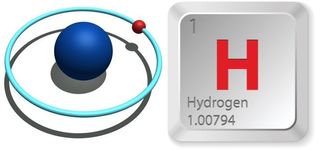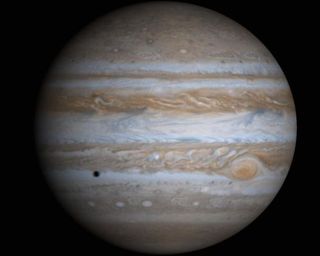Facts About Hydrogen

The most abundant element in the universe, hydrogen is also a promising source of "clean" fuel on Earth.
Named after the Greek words hydro for "water" and genes for "forming," hydrogen makes up more than 90 percent of all of the atoms, which equals three quarters of the mass of the universe, according to the Los Alamos National Laboratory. Hydrogen is essential for life, and it is present in nearly all the molecules in living things, according to the Royal Society of Chemistry. The element also occurs in the stars and powers the universe through the proton-proton reaction and carbon-nitrogen cycle. Stellar hydrogen fusion processes release huge amounts of energy as they combine hydrogen atoms to form helium, according to Los Alamos.
Pure hydrogen gas is scarce in Earth's atmosphere and any hydrogen that actually enters the atmosphere rapidly escapes Earth's gravity, according to the Royal Society. On our planet, hydrogen occurs mainly in combination with oxygen and water, as well as in organic matter such as living plants, petroleum and coal, Los Alamos reports.
Just the facts
- Atomic number (number of protons in the nucleus): 1
- Atomic symbol (on the Periodic Table of Elements): H
- Atomic weight (average mass of the atom): 1.00794
- Density: 0.00008988 grams per cubic centimeter
- Phase at room temperature: Gas
- Melting point: minus 434.7 degrees Fahrenheit (minus 259.34 degrees Celsius)
- Boiling point: minus 423.2 F (minus 252.87 C)
- Number of isotopes (atoms of the same element with a different number of neutrons): 3 common isotopes, including 2 stable ones
- Most common isotope: 1H, natural abundance 99.9885 percent
Hydrogen discovery
Robert Boyle produced hydrogen gas in 1671 while he was experimenting with iron and acids, but it wasn't until 1766 that Henry Cavendish recognized it as a distinct element, according to Jefferson Lab. The element was named hydrogen by the French chemist Antoine Lavoisier.
Hydrogen has three common isotopes: protium, which is just ordinary hydrogen; deuterium, a stable isotope discovered in 1932 by Harold C. Urey; and tritium, an unstable isotope discovered in 1934, according to Jefferson Lab. The difference between the three isotopes lies in the number of neutrons each of them has. Hydrogen has no neutrons at all; deuterium has one, while tritium has two neutrons, according to Lawrence Berkeley National Laboratory. Deuterium and tritium are used as fuel in nuclear fusion reactors, according to Los Alamos.
Hydrogen combines with other elements, forming a number of compounds, including common ones such as water (H2O), ammonia (NH3), methane (CH4), table sugar (C12H22O11), hydrogen peroxide (H2O2) and hydrochloric acid (HCl), according to Jefferson Lab.
Hydrogen is typically produced by heating natural gas with steam to form a mixture of hydrogen and carbon monoxide called syngas, which is then separated to produce hydrogen, according to the Royal Society.
Hydrogen is used to make ammonia for fertilizer, in a process called the Haber process, in which it is reacted with nitrogen. The element is also added to fats and oils, such as peanut oil, through a process called hydrogenation, according to Jefferson Lab. Other examples of hydrogen use include rocket fuel, welding, producing hydrochloric acid, reducing metallic ores and filling balloons, according to Los Alamos. Researchers have been working on developing the hydrogen fuel cell technology that allows significant amounts of electrical power to be obtained using hydrogen gas as a pollution-free source of energy that can be used as fuel for cars and other vehicles.
Hydrogen is also used in the glass industry as a protective atmosphere for making flat glass sheets, while the electronics industry, it is used as a flushing gas in the process of manufacturing silicon chips, according to the Royal Society.

This true-color simulated view of Jupiter is composed of 4 images taken by NASA's Cassini spacecraft on December 7, 2000. The resolution is about 89 miles (144 kilometers) per pixel. Credit: NASA/JPL/University of Arizona
Who knew?
- Hydrogen is the main component of Jupiter and the other gas giant planets, according to Los Alamos.
- The first gas balloon flight was launched in Paris in 1783 and the gas used in the balloon was hydrogen, according to the National Balloon Museum. Its use in filling airships ended when the Hindenburg caught on fire, according to the Royal Society.
- NASA uses hydrogen as rocket fuel to deliver crew to space.
- Liquefied hydrogen is extremely cold and it can cause severe frostbite when it comes into contact with skin.
- Hydrogen is about 14 times lighter than air, according to "The Principles of Chemistry."
- Lavoisier, the French chemist who gave hydrogen its name, served as a financier and public administrator before the French Revolution and was executed during the revolution, according to Encyclopedia Britannica.
- About 3 billion cubic feet of hydrogen are produced in the United States per year, according to Los Alamos.
- Hydrogen has the lowest density of all gases, according to the Royal Society.
- Hydrogen is the only element whose three common isotopes – protium, deuterium and tritium – have been given different names, Los Alamos reports.
Current research
Researchers have been studying hydrogen with great interest for years because of its potential as a pollution-free fuel. "Hydrogen is an energy carrier with no carbon in it, so when you burn it, you only produce water," which makes it a clean fuel, with no emissions at all, said Richard Chahine, the director of the Hydrogen Research Institute at University of Québec at Trois-Rivières in Canada. However, there is a major problem with hydrogen fuel: it is more expensive than gas. In fact, last year, Toyota’s senior vice president Bob Carter announced that, according to the Department of Energy's estimates, a full tank of compressed hydrogen would initially cost around $50, Ecomento.com reported. In general, costs associated with hydrogen fuel technology are "a very challenging barrier because, as of now, people would prefer to have better technologies at the ongoing price," Chahine told Live Science.
Another issue with hydrogen fuel is that the process of hydrogen production itself is in fact not so "clean" or pollution free. "As of today, most of the hydrogen produced comes from natural gas," a process that generates carbon dioxide (CO2), Chahine said.
Researchers have therefore been looking for alternative and more environmentally friendly ways of producing hydrogen that would ideally eliminate CO2 emissions from the process. Last year, for instance, scientists at the U.S. Department of Energy’s Argonne National Laboratory developed a small-scale "nano-sized hydrogen generator," a device that produces pure hydrogen using light and graphene and without burning fossil fuels. The current version of the generator is really small, but if it turns out it can be expanded, it could allow scientists to produce enough hydrogen to provide fuel for cars and generators.
Another way of producing hydrogen, called "biological water splitting," would involve the use of certain photosynthetic microbes that use light energy to produce hydrogen from water as part of their metabolic processes, according to the National Renewable Energy Laboratory, where researchers are currently investigating this process. Another potential method to produce hydrogen involves the fermentation of renewable biomass materials, the NREL reports. Researchers at the NREL have also been working on converting agricultural residues (such as peanut shells) and consumer wastes (such as plastics and waste grease) into a liquid product called bio-oil whose components can then be separated into fuels, including hydrogen. The cleanest way to produce hydrogen, however, is through splitting water into hydrogen and oxygen by using sunlight, the NREL reports.
Additional resources
- Here is more info on hydrogen from the Los Alamos National Laboratory.
- Here is what the Jefferson Lab says about hydrogen.
- The Royal Society of Chemistry also weighs in about hydrogen.
Follow Live Science @livescience, Facebook & Google+.
Sign up for the Live Science daily newsletter now
Get the world’s most fascinating discoveries delivered straight to your inbox.
